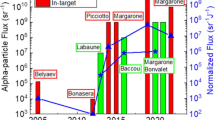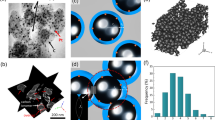Abstract
Depletion calculation is important for studying the transmutation efficiency of minor actinides and long-life fission products in accelerator-driven subcritical reactor system (ADS). Herein the Python language is used to develop a burnup code system called IMPC-Burnup by coupling FLUKA, OpenMC, and ORIGEN2. The program is preliminarily verified by OECD-NEA pin cell and IAEA-ADS benchmarking by comparison with experimental values and calculated results from other studies. Moreover, the physics design scheme of the CIADS subcritical core is utilized to test the feasibility of IMPC-Burnup program in the burnup calculation of ADS system. Reference results are given by the COUPLE3.0 program. The results of IMPC-Burnup show good agreement with those of COUPLE3.0. In addition, since the upper limit of the neutron transport energy for OpenMC is 20 MeV, neutrons with energies greater than 20 MeV in the CIADS subcritical core cannot be transported; thus, an equivalent flux method has been proposed to consider neutrons above 20 MeV in the OpenMC transport calculation. The results are compared to those that do not include neutrons greater than 20 MeV. The conclusion is that the accuracy of the actinide nuclide mass in the burnup calculation is improved when the equivalent flux method is used. Therefore, the IMPC-Burnup code is suitable for burnup analysis of the ADS system.








Similar content being viewed by others
References
A. Stanculescu, Accelerator driven systems (ADSs) for nuclear transmutation. Ann. Nucl. Energy 62, 607–612 (2013)
W.R. Martin, Challenges and prospects for whole-core Monte Carlo analysis. Nucl. Eng. Technol. 44, 151–160 (2012). https://doi.org/10.5516/NET.01.2012.502
R.L. Moore, B.G. Schnitzler, C.A. Wemple, et al., MOCUP:MCNP-ORIGEN2 coupled utility program. INEL-95/0523 (1995)
G.L. Yu, K. Wang, Y.H. Wang, MCBurn—a coupling package of program MCNP and ORIGEN. Atom. Energy Sci. Technol. 37, 250–254 (2003). https://doi.org/10.3969/j.issn.1000-6931.2003.03.014. (in Chinese)
A. Talamo, W. Ji, J. Centar et al., Comparison of MCB and MONTEBURNS Monte Carlo burnup codes on a one-pass deep burn. Ann. Nucl. Energy 33, 1176–1188 (2006). https://doi.org/10.1016/j.anucene.2006.08.006
A. Stankovskiy, G.V.D. Eynde, P. Baeten. et al., ALEPH2—a general purpose Monte Carlo depletion code. Paper presented at PHYSOR 2012: Conference on Advances in Reactor Physics—Linking Research, Industry, and Education. Knoxville, Tennessee, USA, 15–20 April (2012)
J. Leppänen, M. Pusa, T. Viitanen et al., The Serpent Monte Carlo code: status, development and applications in 2013. Ann. Nucl. Energy 82, 142–150 (2014). https://doi.org/10.1051/snamc/201406021
K. Wang, Z. Li, D. She et al., RMC—a Monte Carlo code for reactor core analysis. Ann. Nucl. Energy 82, 121–129 (2015). https://doi.org/10.1051/snamc/201406020
G. Li, B. Zhang, L. Deng et al., Development of Monte Carlo particle transport code JMCT. High Power Laser Part. Beams 25, 158–162 (2013). https://doi.org/10.3788/HPLPB20132501.0158. (in Chinese)
J.Y. Li, L. Gu, R. Yu et al., Development and validation of burnup-transport code system OMCB for accelerator driven system. Nucl. Eng. Des. 324, 360–371 (2017). https://doi.org/10.1016/j.nucengdes.2017.09.012
X.Z. Li, H.C. Wu, Y.Q. Zheng et al., Development and application of high-energy nuclear data library for accelerator driven sub-critical system. Atom. Energy Sci. Technol. 49, 371–376 (2015). https://doi.org/10.7538/yzk.2015.49.S0.0371. (in Chinese)
D. Pelowitz. MCNPX User’s Manual 2.7. 0. Los Alamos National Laboratory, Los Alamos, New Mexico (2011)
H.Q. Li, Y.W. Yang, The Development of Burn-up Program COUPLE by Combining MCNP and ORIGEN, Conference of Chinese Reactor Physics, Qinshan, China, Augest 8–12 (2004)
A.G. Croff, A User’s Manual for the ORIGEN2 Computer Code. ORNL/TM-7175 (1980)
P.K. Romano, B. Forget, The OpenMC Monte Carlo particle transport code. Ann. Nucl. Energy 51, 274–281 (2013). https://doi.org/10.1016/j.anucene.2012.06.040
A. Ferrari, P.R. Sala, A. Fasso et al., FLUKA: a multi-particle transport code. Lancet 10(7740), 44–45 (2005). https://doi.org/10.2172/877507
S. Hong, Y.W. Yang, H.S. Xu et al., Application of Origen2.1 in the decay photon spectrum calculation of spallation products. Chin. Phys. C. 40, 82–87 (2016). https://doi.org/10.1088/1674-1137/40/11/114102
P.K. Romano, N.E. Horelik, B.R. Herman et al., OpenMC: a state-of-the-art Monte Carlo code for research and development. Ann. Nucl. Energy 82, 90–97 (2014). https://doi.org/10.1016/j.anucene.2014.07.048
A. Gul, K.S. Chaudri, R. Khan et al., Development and verification of LOOP: a linkage of ORIGEN2.2 and OpenMC. Ann. Nucl. Energy 99, 321–327 (2016). https://doi.org/10.1016/j.anucene.2016.09.016
M.D. Dehart, M.C. Brady, C.V. Parks, OECD/NEA burnup credit calculational criticality benchmark Phase I-B results. ORNL-6901 (1996)
I. Slessarev, A. Tchistiakov, IAEA ADS-benchmark results and analysis (TCM-Meeting, Madrid, Spain, Madrid, 1997)
X.F. Jiang, Z. Xie, Transport-burnup code systems and their applications for IAEA ADS benchmark. Ann. Nucl. Energy 31(2), 213–225 (2004). https://doi.org/10.1016/S0306-4549(03)00205-6
Acknowledgements
The first author would like to acknowledge Mr. Hong Shuang for the technical support of FLUKA and OpenMC coupled calculation.
Author information
Authors and Affiliations
Corresponding authors
Additional information
This work was supported by the “Strategic Priority Research Program” of Chinese Academy of Sciences (No.XDA03030102).
Rights and permissions
About this article
Cite this article
Liu, ZQ., Zhao, ZL., Yang, YW. et al. Development and validation of depletion code system IMPC-Burnup for ADS. NUCL SCI TECH 30, 44 (2019). https://doi.org/10.1007/s41365-019-0560-z
Received:
Revised:
Accepted:
Published:
DOI: https://doi.org/10.1007/s41365-019-0560-z




